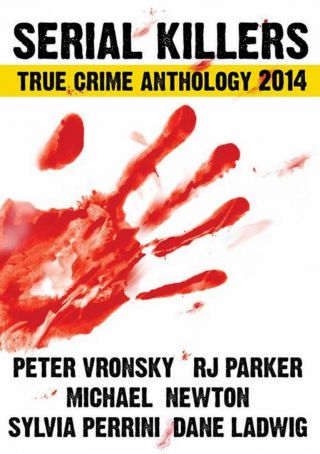Serial Killers
A Murder of Pros
A collaborative effort by writers produces the first serial killer anthology.
Posted April 18, 2014

A group of crows is called a “murder.” It seems an appropriate term for a gathering of true crime authors as well, since the crow is a liminal bird, representing the threshold between life and death.
Bestselling author and publisher RJ Parker presents Serial Killers True Crime Anthology, the first known collection of diverse narratives by different authors devoted entirely to true tales of serial murder. He gathered other bestselling authors, and collectively, the killers they chose for this debut book have amassed at least 500 victims.
The point of this work was to offer details of some lesser known killers, such as Frank Spisak and Anthony Sowell, or to tell a known story, like that of young Mary Bell, in a unique way not seen before.
“After doing some research,” says Parker, who has penned numerous crime books, including Cold-blooded Killers, “I discovered there wasn't any serial killer anthology published before, except in fiction. I had planned on an Amazon Imprint to pub it, but in order to secure Peter Vronsky, he wanted me to pub it.”
Vronsky, a historian of criminal justice, teaches at Ryerson University in Toronto. He’s penned several bestselling histories of serial murder, including one that focuses on females. When Parker approached him, Vronsky was interested in exploring options outside traditional publishing. He partnered with Parker to “catch the wave” of what he sees as publishing’s future.
“I like the 'interactivity' between RJ Parker as a publisher with the buyer that no legacy mainstream publisher has been able to establish,” Vronsky offers. “I find that RJ does more as a publisher for each of his books than other 'old school publishers.' I appreciate his 'hands on' promotion and nurturing of the books he publishes.”
I asked Vronsky to say something about his contribution, since it is a socio-historic essay that opens the book, rather than a specific case narrative.
“‘Serial Killer Zombie Apocalypse and the Dawn of the Less Dead,’ which I contributed as an introduction,” he explains, “is an excerpt from my next book, Serial Killer Chronicles: A New History of Serial Murder Today. In comparing the brain functions of a fictional zombie with those of a serial killer, I argue that a human’s capacity for serial murder, rape, and cannibalism, are deeply rooted in primitive survival instincts that “misfire” for a complexity of reasons, ranging from familial, environmental, social, cultural, to perhaps even bio-chemical or genetic.
“It is my goal to construct a macro history of serial homicide, not just as a recent socio-historical and cultural phenomenon but also in its evolutionary psychopathological and physiological contexts. I believe the key to understanding the recent 50-year surge in serial killing lurks somewhere in an interplay between deeply seated so-called ‘reptilian brain’ survival functions and cultural norms as expressed in visual media, especially post-World War II era popular illustrated media.
“In other words, in the way the abundance of readily available food clashes with the still relatively primitive survival function of the human to store energy in the form of fat to compensate for periods of famine, in the modern world resulting in the rise of obesity, our cultural obsession with rape and murder as a staple of non-explicit titillating visual popular entertainment, from illustrated detective magazines, pulp literature, B-movies and television, has inspired a rising wave of serial killers to act out these fantasies.”
Vronksy seeks an over-arching explanation for multiple murder trends, while another contributor, Michael Newton, is known for his extensive Encyclopedia of Serial Killers. A former writer for CourtTV’s Crime Library (now under the auspices of TruTv), he enjoys working on the details of single cases.
“If not writing an encyclopedic work, where I throw in the bloody kitchen sink,” Newton says, “I focus on cases that stand out in some way, be it an unlikely perpetrator, a particular bizarre technique, an extreme body, a gross failure by law enforcement—whatever.”
Parker had asked the authors involved to select two cases about which they had never before written. For Newton, this was a challenge: “I reminded RJ that amongst my various SK encyclopedias I'd basically written about everyone, so he told me to pick two at random. I went with Liz Bathory [the so-called Blood Countess] and Frank Spisak [a Nazi transvestite] as two of my favorite perps.” He also wrote about a serial killer cop, Manuel Pardo.
Dane Ladwig, who has explored the link between H. H. Holmes and Jack the Ripper, provided an illustrated tale of the “bloody Benders,” who killed a number of hapless travelers. More intimate is his portrait of the notorious Timothy Krajcir, whom he interviewed. He provides the interview verbatim, along with a psychological evaluation that Krajcir underwent. Then he gives his own succinct analysis.
The only female author in this anthology is the prolific British writer Sylvia Perrini, also a historian. Her subject areas include female rampage killers and historical female serial killers. She writes here about a poisoner named Martha Wise, as well as the child-killer, Mary Bell (a child who killed children). Although Gitta Sereny’s book had fully explored Bell, Perrini provides an aftermath that brings the reader up-to-date.
Parker, who supervised this unique project, depicts Canadian pig farmer Robert Pickton, whose gruesome trial for just six of his dozens of suspected victims lasted nearly a year. Parker also focuses on Anthony Sowell, the Cleveland killer who exploited the proximity of a smelly meat processing business to cover the odors of the bodies collecting in his home.
Parker envisions an annual publication of this diverse and informative anthology, and he adds it's the only book that is digitally autographed by all the writers.
Serial Killers True Crime Anthology is a unique "murder" of pros and prose that will satisfy true crime fans. Each and every contribution offers something new.




